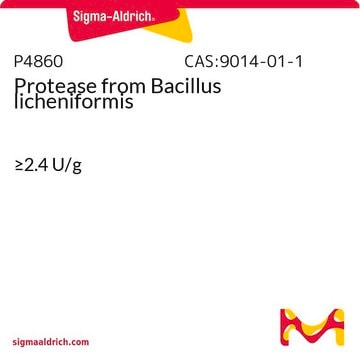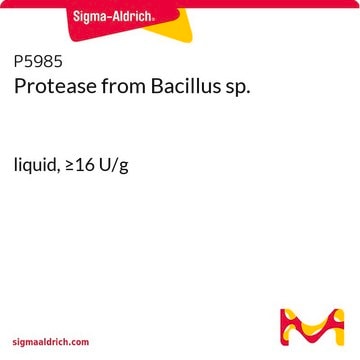P2143
Protease from Aspergillus saitoi
Type XIII, ≥0.6 unit/mg solid
Synonym(s):
Molsin
Sign Into View Organizational & Contract Pricing
All Photos(1)
About This Item
Recommended Products
biological source
Aspergillus sp. (Aspergillus saitoi)
type
Type XIII
form
solid
specific activity
≥0.6 unit/mg solid
foreign activity
alkaline protease, essentially free
storage temp.
−20°C
Application
Protease from Aspergillus saitoi has been used in a study to assess sequence coverage and resolution in hydrogen exchange of large proteins. It has also been used in a study to investigate the conversion of soybean curd isoflavone glycosides to their aglycones through β-glucosidase..
Biochem/physiol Actions
Protease from Aspergillus saitoi was shown to also function as a β-glucosidase.
Unit Definition
One unit will hydrolyze hemoglobin to produce color equivalent to 1.0 μmole (181 μg) of tyrosine per min at pH 2.8 at 37 °C (color by Folin-Ciocalteu reagent).
signalword
Danger
hcodes
Hazard Classifications
Eye Irrit. 2 - Resp. Sens. 1 - Skin Irrit. 2 - STOT SE 3
target_organs
Respiratory system
Storage Class
11 - Combustible Solids
wgk_germany
WGK 3
flash_point_f
Not applicable
flash_point_c
Not applicable
Certificates of Analysis (COA)
Search for Certificates of Analysis (COA) by entering the products Lot/Batch Number. Lot and Batch Numbers can be found on a product’s label following the words ‘Lot’ or ‘Batch’.
Already Own This Product?
Find documentation for the products that you have recently purchased in the Document Library.
Customers Also Viewed
E Ichishima
Bioscience, biotechnology, and biochemistry, 64(4), 675-688 (2000-06-01)
This review covers the unique catalytic and molecular properties of three proteolytic enzymes and a glycosidase from Aspergillus. An aspartic proteinase from A. saitoi, aspergillopepsin I (EC 3.4.23.18), favors hydrophobic amino acids at P1 and P'1 like gastric pepsin. However
F J Moralejo et al.
Applied microbiology and biotechnology, 54(6), 772-777 (2001-01-11)
A gene encoding the sweet-tasting protein thaumatin (tha) with optimized codon usage was expressed in Aspergillus awamori. Mutants of A. awamori with reduced proteolytic activity were isolated. One of these mutants, named lpr66, contained an insertion of about 200 bp
E Skyttä et al.
The Journal of applied bacteriology, 74(2), 134-142 (1993-02-01)
The broad-spectrum antibacterial activity exhibited by three Pediococcus strains isolated from beer was preliminarily characterized. Factors affecting the production rate of bacterial inhibitors were screened and the effects of simultaneous cultivation of Lactococcus and Pediococcus on the production of inhibitory
R E Cardoza et al.
Biotechnology and bioengineering, 83(3), 249-259 (2003-06-05)
A copy of the bovine chymosin gene (chy) with a codon usage optimized for its expression in Aspergillus awamori was constructed starting from synthetic oligonucleotides. To study the ability of this filamentous fungus to secrete bovine prochymosin, two plasmids were
Isolation and characterization of mutants of Aspergillus niger deficient in extracellular proteases.
I E Mattern et al.
Molecular & general genetics : MGG, 234(2), 332-336 (1992-08-01)
In the present study, the extracellular protease activity in a strain of the filamentous fungus Aspergillus niger was investigated and mutant strains deficient in the production of extracellular proteases were isolated. The major protease, which is responsible for 80-85% of
Our team of scientists has experience in all areas of research including Life Science, Material Science, Chemical Synthesis, Chromatography, Analytical and many others.
Contact Technical Service












